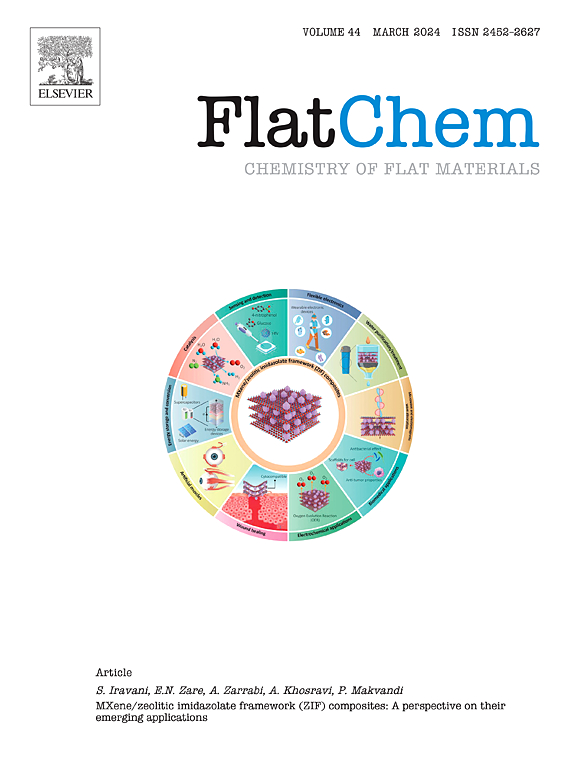用于神经形态应用的可持续垂直导向石墨烯电极忆阻器
IF 5.9
3区 材料科学
Q2 CHEMISTRY, PHYSICAL
引用次数: 0
摘要
神经形态计算是电子和计算工程领域的一个创新领域,旨在通过模拟大脑过程来改进计算模式。忆阻器是一种双端器件,有望通过规避冯-诺伊曼瓶颈彻底改变神经形态架构。忆阻器的性能和适用性在很大程度上取决于所采用的材料和制造工艺。石墨烯具有独特的性能,可在忆阻器设计中加以利用。此外,石墨烯还是一种有潜力通过等离子体增强化学气相沉积(PECVD)技术实现大规模、可持续生产的材料。值得注意的是,石墨烯电极忆阻器的特性会因不同的 PECVD 温度而产生细微的结构差异。本文报告了利用一种可持续植物提取物,通过省时、经济的 PECVD 技术合成石墨烯电极,并将其用于忆阻器。此外,本文还深入研究了这些结构变化如何影响石墨烯忆阻器的特性,并探讨了在神经形态应用中利用石墨烯忆阻器实现著名的尖峰时序可塑性(STDP)学习机制的潜力。本文还利用所开发的 STDP 学习机制执行了一项基于尖峰模式的无监督分类任务。本文章由计算机程序翻译,如有差异,请以英文原文为准。

Sustainable vertically-oriented graphene-electrode memristors for neuromorphic applications
Neuromorphic computing, an innovative field in electronic and computing engineering, aims to enhance computing paradigms by simulating brain processes. Memristors, a two-terminal device, hold promise in revolutionising neuromorphic architectures by circumventing the Von-Neumann bottleneck. The performance and applicability of memristors heavily rely on the materials and fabrication processes employed. Graphene exhibits unique properties that can be leveraged in memristor design. Moreover, graphene stands out as a material with the potential for large-scale, sustainable production through Plasma Enhanced Chemical Vapour Deposition (PECVD). Notably, the properties of graphene-electrode memristors vary with minor structural differences induced by different PECVD temperatures. This paper reports the synthesis of graphene electrodes by time- and cost-effective PECVD from a sustainable plant extract for memristors. In addition, this paper delves into investigating how these structural variations impact the properties of graphene memristors and explores their potential exploitation in neuromorphic applications for implementing the well-known Spike Timing Dependent Plasticity (STDP) learning mechanism. The paper also utilises the developed STDP learning to perform an unsupervised spike-based pattern classification task.
求助全文
通过发布文献求助,成功后即可免费获取论文全文。
去求助
来源期刊

FlatChem
Multiple-
CiteScore
8.40
自引率
6.50%
发文量
104
审稿时长
26 days
期刊介绍:
FlatChem - Chemistry of Flat Materials, a new voice in the community, publishes original and significant, cutting-edge research related to the chemistry of graphene and related 2D & layered materials. The overall aim of the journal is to combine the chemistry and applications of these materials, where the submission of communications, full papers, and concepts should contain chemistry in a materials context, which can be both experimental and/or theoretical. In addition to original research articles, FlatChem also offers reviews, minireviews, highlights and perspectives on the future of this research area with the scientific leaders in fields related to Flat Materials. Topics of interest include, but are not limited to, the following: -Design, synthesis, applications and investigation of graphene, graphene related materials and other 2D & layered materials (for example Silicene, Germanene, Phosphorene, MXenes, Boron nitride, Transition metal dichalcogenides) -Characterization of these materials using all forms of spectroscopy and microscopy techniques -Chemical modification or functionalization and dispersion of these materials, as well as interactions with other materials -Exploring the surface chemistry of these materials for applications in: Sensors or detectors in electrochemical/Lab on a Chip devices, Composite materials, Membranes, Environment technology, Catalysis for energy storage and conversion (for example fuel cells, supercapacitors, batteries, hydrogen storage), Biomedical technology (drug delivery, biosensing, bioimaging)
 求助内容:
求助内容: 应助结果提醒方式:
应助结果提醒方式:


